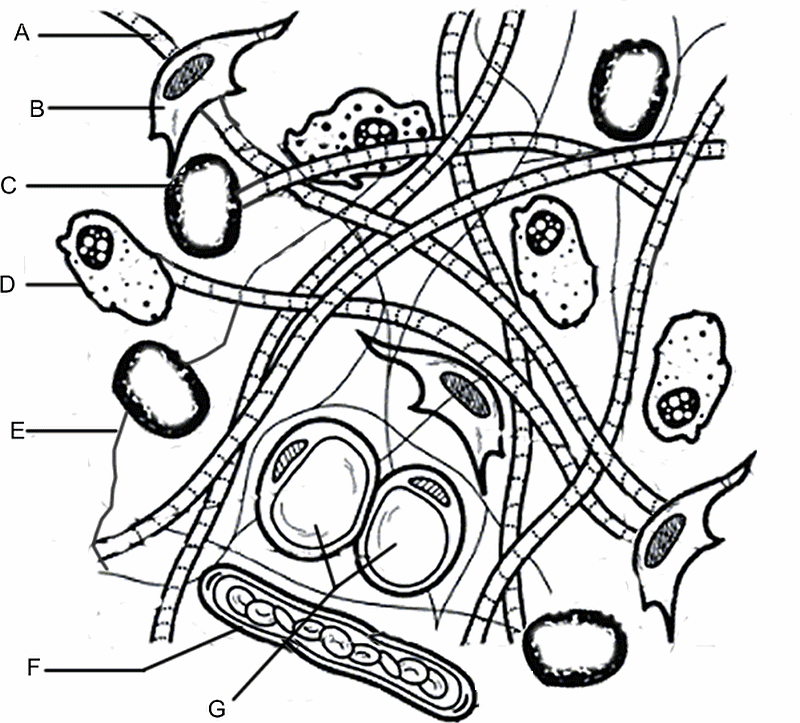Color the Connective Tissue Matrix

Coloring Instructions - Color each according to the key below, then label each cell on the diagram.
Match the structure to the function (use letters)
1. ____ Store energy
2. ____ Production of fibers
3. ____ Consume debris and foreign objects
4. ____ Fiber that makes up tendons
5. ____ Prevention of blood clots
![]() collagen
fibers [A] yellow.
collagen
fibers [A] yellow.
![]() fibroblasts
[B] blue.
fibroblasts
[B] blue.
![]() mast
cells [C] purple .
mast
cells [C] purple .
![]() macrophages
[D] orange
macrophages
[D] orange
![]() elastic
fibers [E] green (shade over the line)
elastic
fibers [E] green (shade over the line)
![]() blood
vessel and blood cells [F] red.
blood
vessel and blood cells [F] red.
![]() fat
cells [G] pink.
fat
cells [G] pink.
Connective Tissue Matrix
Ground Substance: This is a gel-like, amorphous material that fills the space between cells and fibers
Fibers: The fibers within the matrix provide structural support and contribute to the tissue's mechanical properties. The main types of fibers found in the matrix of connective tissue include:
-
Collagen fibers: These are the most abundant fibers and provide tensile strength to the tissue. Collagen fibers are arranged in bundles and give tissues resistance to stretching and tearing.
-
Elastic fibers: Composed of elastin and other proteins, these fibers are responsible for elasticity and recoil in tissues. They allow tissues to stretch and return to their original shape.
Various types of cells are present within the connective tissue matrix, each serving specific functions:
-
Fibroblasts: These are the most common cells found in connective tissue. Fibroblasts are responsible for producing and secreting the extracellular matrix components, including collagen, elastin, and other structural proteins. They play a central role in tissue repair and maintenance.
-
Adipocytes: These are specialized cells that store fat in the form of lipid droplets. Adipose tissue, where adipocytes are predominant, serves as an energy reservoir and also provides cushioning and insulation.
-
Macrophages: These are immune cells involved in the defense against pathogens and cellular debris. They participate in phagocytosis (engulfing and digesting foreign particles), clearing out dead cells, and secreting signaling molecules that regulate immune responses.
-
Mast Cells: These cells are involved in the body's inflammatory responses. They contain granules filled with substances like histamine, which are released in response to injury or allergens, triggering inflammation and immune reactions.


